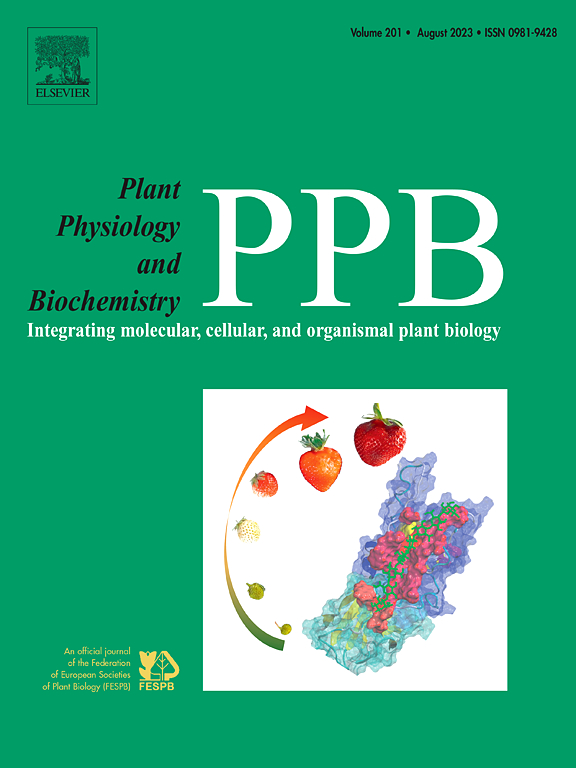Salvia miltiorrhiza-derived carbon dots alleviate cadmium stress in flowering Chinese cabbage by suppressing BrTCP9-mediated cadmium transport and reactive oxygen species metabolism
IF 5.7
2区 生物学
Q1 PLANT SCIENCES
引用次数: 0
Abstract
Cadmium stress not only inhibits vegetable growth but also threatens food safety. Carbon dots (CDs) and TCP transcription factors play crucial roles in responding to abiotic stress. As a leafy vegetable, flowering Chinese cabbage exhibits heightened vulnerability to cadmium contamination. However, the molecular mechanism by which CDs may alleviate cadmium stress through TCP-mediated regulation of cadmium transport and reactive oxygen species (ROS) metabolism remains unclear. In this study, we found that Salvia miltiorrhiza-derived CDs (SmCDs) alleviated cadmium stress in flowering Chinese cabbage in a concentration-dependent manner. An optimal concentration of SmCDs significantly enhanced cadmium tolerance and plant growth. Furthermore, TCP transcription factor simultaneously induced by cadmium and suppressed by SmCDs was identified as BrTCP9, while the cadmium transporter and Rboh gene were identified as BrNramp1.2 and BrRbohA, respectively. Under cadmium stress, silencing BrTCP9, BrNramp1.2, or BrRbohA markedly suppressed ROS production, reduced both cadmium and malondialdehyde accumulation, and promoted plant growth, with SmCDs application further enhancing these effects. Intriguingly, BrNramp1.2 and BrRbohA were found to mutually regulate each other under cadmium stress. Y1H, LUC, GUS, and EMSA assays confirmed that BrTCP9 directly binds to the promoter of BrNramp1.2 and BrRbohA, activating their expression. These results indicated that BrTCP9, BrNramp1.2, and BrRbohA negatively regulated cadmium tolerance, whereas SmCDs mitigated cadmium stress by suppressing BrTCP9-mediated BrNramp1.2 and BrRbohA expressions. This study not only expanded the molecular network of cadmium stress response but also provided theoretical foundation for the application of carbon nanomaterials in agricultural heavy metal remediation.

丹参碳点通过抑制brtcp9介导的镉转运和活性氧代谢缓解开花白菜镉胁迫
镉胁迫不仅抑制蔬菜生长,而且威胁食品安全。碳点和TCP转录因子在应对非生物胁迫中起着至关重要的作用。作为一种叶菜,开花白菜对镉污染表现出高度脆弱性。然而,CDs可能通过tcp介导的镉转运和活性氧(ROS)代谢调节来缓解镉胁迫的分子机制尚不清楚。在本研究中,我们发现丹参衍生cd (SmCDs)以浓度依赖的方式缓解了开花白菜的镉胁迫。smcd的最佳浓度显著提高了植物的耐镉性和生长。同时被镉诱导并被smcd抑制的TCP转录因子鉴定为BrTCP9,镉转运体和Rboh基因分别鉴定为BrNramp1.2和BrRbohA。在镉胁迫下,沉默BrTCP9、BrNramp1.2或BrRbohA可显著抑制ROS的产生,减少镉和丙二醛的积累,促进植物生长,而smcd的应用进一步增强了这些作用。有趣的是,BrNramp1.2和BrRbohA在镉胁迫下相互调节。Y1H、LUC、GUS和EMSA实验证实,BrTCP9直接结合BrNramp1.2和BrRbohA的启动子,激活它们的表达。这些结果表明,BrTCP9、BrNramp1.2和BrRbohA负向调节镉耐受性,而smcd通过抑制BrTCP9介导的BrNramp1.2和BrRbohA的表达来减轻镉胁迫。本研究不仅拓展了镉胁迫响应的分子网络,也为碳纳米材料在农业重金属修复中的应用提供了理论基础。
本文章由计算机程序翻译,如有差异,请以英文原文为准。
求助全文
约1分钟内获得全文
求助全文
来源期刊
CiteScore
11.10
自引率
3.10%
发文量
410
审稿时长
33 days
期刊介绍:
Plant Physiology and Biochemistry publishes original theoretical, experimental and technical contributions in the various fields of plant physiology (biochemistry, physiology, structure, genetics, plant-microbe interactions, etc.) at diverse levels of integration (molecular, subcellular, cellular, organ, whole plant, environmental). Opinions expressed in the journal are the sole responsibility of the authors and publication does not imply the editors'' agreement.
Manuscripts describing molecular-genetic and/or gene expression data that are not integrated with biochemical analysis and/or actual measurements of plant physiological processes are not suitable for PPB. Also "Omics" studies (transcriptomics, proteomics, metabolomics, etc.) reporting descriptive analysis without an element of functional validation assays, will not be considered. Similarly, applied agronomic or phytochemical studies that generate no new, fundamental insights in plant physiological and/or biochemical processes are not suitable for publication in PPB.
Plant Physiology and Biochemistry publishes several types of articles: Reviews, Papers and Short Papers. Articles for Reviews are either invited by the editor or proposed by the authors for the editor''s prior agreement. Reviews should not exceed 40 typewritten pages and Short Papers no more than approximately 8 typewritten pages. The fundamental character of Plant Physiology and Biochemistry remains that of a journal for original results.

 求助内容:
求助内容: 应助结果提醒方式:
应助结果提醒方式:


